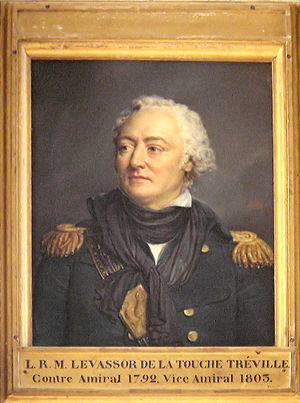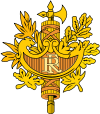- Louis-René Levassor de Latouche Tréville
-
Louis-René Levassor de Latouche Tréville 
Born 3 June 1745
Rochefort-sur-mer, FranceDied 19 August 1804 (aged 59)
Toulon, FranceAllegiance  France
FranceRank Amiral (France) Battles/wars American Revolutionary War Louis-René Levassor de Latouche Tréville (3 June 1745 – 19 August 1804) was a French admiral and a hero of the American Revolutionary War and of the Napoleonic wars.
Contents
Early life
Latouche Tréville was born in Rochefort-sur-mer, Charente-Maritime, in a family of sailors. At the age of 13, he joined the Gardes-Marines ("Naval Guards"), and took part in numerous naval actions during the Seven Years' War. He took part in his first action in 1759 aboard the Dragon, which was under his father's command. He also served on the Louise and the Intrépide, the Tonnant in 1762, the Garonne in 1763, and the Hardi and the Bricole in 1765.
In September 1768, aged 23, he was promoted to enseigne de vaisseau. Under pressure from his family, he quit the Navy to become a cavalry officer. He became a captain in April 1769, and served as an aide to the governors of Martinique and Saint-Domingue in 1770 and 1771.
In 1772 he rejoined the Navy as "capitaine de brûlot". He served in Rochefort between 1773 and 1776.
American Revolution
Main article: Franco-American allianceIn 1776, he transported ammunition from France to the United States of America. In May 1777 he was promoted to lieutenant de vaisseau and was granted the command of the corvette the Rossignol, which escorted convoys. He captured two English privateers and three merchantmen.
In the spring of 1780, as captain of the frigate Hermione, at the beginning of the American Revolutionary War, he was entrusted with General La Fayette as a passenger on a transatlantic voyage from France to Boston. He took part in the American campaign under the command of Des Touches and was involved in several battles, including a fierce but indecisive action in June 1780 against the 32-gun British frigate Iris (formerly the USS Hancock), under the command of James Hawker. He was promoted to capitaine de vaisseau in June 1781.
On 21 July, along with the frigate Astrée (under La Pérouse), he attacked an English convoy near the coast of New Scotland in the Naval battle of Louisbourg; the escorts Jack and Thorn were captured, along with three merchantmen, and brought back to Boston. He also took part in the battle of Yorktown.
Latouche-Tréville assumed command of the frigate Aigle which, along with the Gloire, ferried funds and equipment for the fleet of Admiral Vaudreil. On 5 September 1782, he sank the English vessel Hector, but ran aground in the mouth of the Delaware River. There HMS Vestal, strike her colours on 15 September. The British took Aigle into service under her own name. Latouche was freed when the peace was signed in 1783.
In 1784 he succeeded Bruni d'Entrecasteaux as vice-director of the Harbours and Arsenals. In 1786 he became Inspector General of Gunnery, and in 1787, Chancellor of the Duke of Orléans. In 1788, he added "Tréville" to his name, becoming "Latouche-Tréville".
French Revolution
At the beginning of the French Revolution, in 1789, Latouche Tréville was a deputy of the Second Estate (the nobility) and a member of the National Constituent Assembly, taking a liberal posture and contributing to the foundation of the Republic.
In September 1791, after Louis XVI approved the new constitution, the National Constituent Assembly was disbanded; Latouche-Tréville then took the command of a squadron of four ships of the line that he sailed from Brest to Toulon, with his flag on Languedoc.
He joined contre-amiral Truguet and supported the operation of the Army of Italy. He also took part in the attack on Sardinia in October 1792, which turned out to be a failure when the Sardinians repulsed the expeditionary corps, which had landed on 14 February. Latouche-Tréville and Truguet then sailed to Toulon.
On 1 January 1793 war broke out with England. Latouche-Tréville was promoted to contre-amiral and began planning for an invasion of England. On 28 March his plan for a landing, and in particular the construction of a specialised fleet of light troop transports, was adopted.
In March he took command of the Naval Army of Brest. As soon as he took up his position, subordinates denounced him as a noble. He was arrested in September as a "suspect", at the height of the Terror. He spent one year in the Force prison and was freed only after the fall of Robespierre.
Under the Directoire he was rehabilitated and regained his rank in December 1795. However, he was offered no position and went to Montargis. He was so desperate that in 1799, he ran an announcement in the Moniteur newspaper asking for a position as a privateer.
Napoleonic Era
In 1801, Bonaparte gave Latouche-Tréville command of a fleet in Brest. Interested by the plans for the invasion of England, Bonaparte and Minister Forfait gave him command of a flotilla in Boulogne. In this position, on 4 August and 15 August 1801, Latouche-Tréville repelled the attacks of Admiral Nelson.
The British lost six ships sunk and one captured. Casualties amounted to 44 dead (including Parker, aide to Nelson), 126 wounded and three prisoners. The French lost one vessel captured. Their casualties numbered eight men killed, 12 missing and 34 wounded.
On 30 October 1801, with the Treaty of Amiens, Latouche-Tréville was given command of the fleet of Rochefort, which carried part of the leading 23,000 men of the Army of Rhine for the expedition, under Admiral Villaret de Joyeuse, against rebel black slaves in Saint-Domingue. Arriving first at Saint-Domingue, he and general Boudet captured Port-au-Prince and Léogane. Latouche-Tréville managed to obtain the peaceful surrender of General Laplume, while, in the south, General Leclerc forced Toussaint L'Ouverture and Christophe to submit to French authority.
With Villaret de Joyeuse's departure in April 1802, Latouche-Tréville stayed in Saint-Domingue with four ships-of-the-line, nine frigates and five corvettes. After the restoration of slavery, on 20 May 1802, a new rebellion broke out, which overwhelmed the yellow fever-stricken army of General Leclerc. Latouche-Tréville defended the harbours in the south, giving the western part to Admiral Willaumez. After the English entered the war, and before Rochambeau and his army were captured, Latouche-Tréville obtained a free passage back to France in October 1803 due to his poor health.
He was made a vice-Admiral in December 1803, taking command of the Mediterranean fleet at Toulon. He raised his flag on the Bucentaure, regularly repelling Nelson's fleet, which blockaded the harbour.
A new plan for the invasion of England was drawn up, with 2,500 vessels. In the plan, Napoleon gave Latouche-Tréville the task of commanding the fleet that would hold the English Channel during the landing.
Admiral Latouche-Tréville died on 18 August 1804, aged 59. He suffered a heart attack after climbing the hill to the signal station to get a view of the English ships blockading the port. His replacement was Admiral Villeneuve.
Trivia
- "I have no doubt that as soon as he will receive a mission, he would be the kind of man who, to accomplish it and execute his orders, would risk encountering and fighting us". – Horatio Nelson.
- "...from the time of his meeting Captain Hawker in the Iris, I never heard of his acting other than as a poltroon and a liar. Contempt is the best mode of treating such a miscreant." -- Horatio Nelson
- Three warships of the French Navy have been named in his honour, including the presently operational F70 type frigate Latouche-Tréville; see (French ship Latouche-Tréville for the others).
- Commonly repeated mistake about Latouche-Tréville's record is the "battle against the Chesapeake (March 1781)" In fact, Latouche-Tréville participated in the often forgotten Battle of Chesapeake Bay. This error can be traced to George Six's Dictionnaire Biographique des Généraux et Amiraux Français de la Révolution et de l'Empire 1792–1814, 1934, and often cited from there.
References
French Armed Forces Components French Air Force French Army French Navy Gendarmerie Ranks Ranks in the French Army Ranks in the French Navy History of the French Military Military History of France La Grande Armée - Rémi Monaque, Latouche-Tréville, 1745–1804 : l'amiral qui défiait Nelson, éditions SPM, 2000, ISBN 2901952364
Categories:- 1745 births
- 1804 deaths
- People from Rochefort, Charente-Maritime
- French Navy admirals
- French naval commanders of the Napoleonic Wars
- Members of the Society of the Cincinnati
Wikimedia Foundation. 2010.




